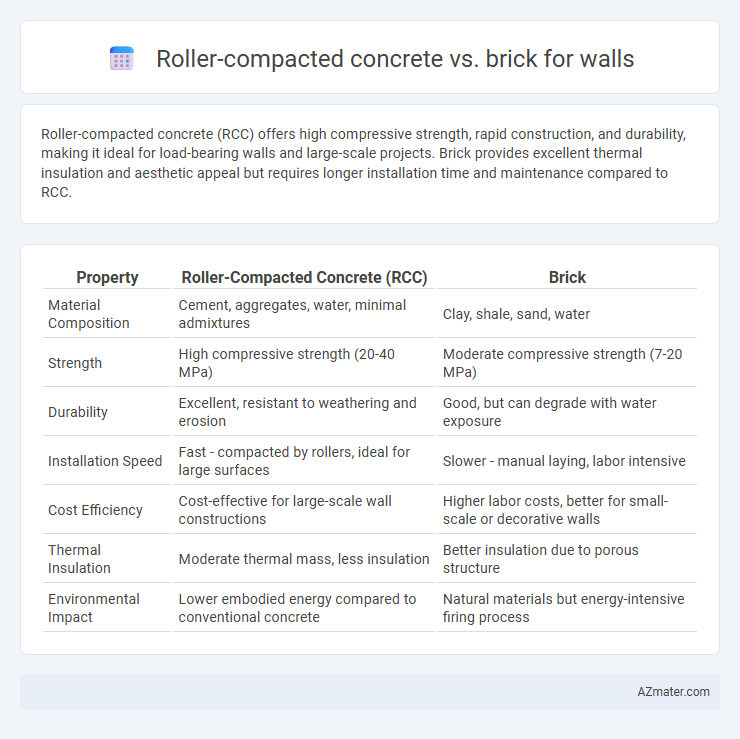Roller-compacted concrete (RCC) offers high compressive strength, rapid construction, and durability, making it ideal for load-bearing walls and large-scale projects. Brick provides excellent thermal insulation and aesthetic appeal but requires longer installation time and maintenance compared to RCC.
Table of Comparison
| Property | Roller-Compacted Concrete (RCC) | Brick |
|---|---|---|
| Material Composition | Cement, aggregates, water, minimal admixtures | Clay, shale, sand, water |
| Strength | High compressive strength (20-40 MPa) | Moderate compressive strength (7-20 MPa) |
| Durability | Excellent, resistant to weathering and erosion | Good, but can degrade with water exposure |
| Installation Speed | Fast - compacted by rollers, ideal for large surfaces | Slower - manual laying, labor intensive |
| Cost Efficiency | Cost-effective for large-scale wall constructions | Higher labor costs, better for small-scale or decorative walls |
| Thermal Insulation | Moderate thermal mass, less insulation | Better insulation due to porous structure |
| Environmental Impact | Lower embodied energy compared to conventional concrete | Natural materials but energy-intensive firing process |
Introduction to Roller-Compacted Concrete and Brick Walls
Roller-compacted concrete (RCC) is a highly durable, low-slump concrete mix applied with asphalt paving equipment and compacted by rollers, offering superior structural strength and rapid construction for walls. Brick walls, composed of fired clay bricks laid in mortar, provide traditional aesthetic appeal, excellent thermal insulation, and proven long-term durability. Both RCC and brick walls serve distinct purposes, with RCC favored for industrial and large-scale infrastructure projects and brick walls preferred in residential and architectural applications.
Material Composition and Properties
Roller-compacted concrete (RCC) consists of a dry mixture of cement, coarse aggregates, and water with minimal fines, resulting in a dense, high-strength material ideal for structural walls requiring durability and load-bearing capacity. Brick walls are composed primarily of fired clay or concrete blocks with porous structures that provide good thermal insulation but lower compressive strength compared to RCC. RCC offers superior resistance to moisture and weathering, while brick walls excel in aesthetic appeal and traditional construction methods.
Construction Techniques and Processes
Roller-compacted concrete (RCC) walls utilize a dry mix that is placed using heavy machinery and compacted with rollers, enabling rapid construction and high structural strength suitable for large-scale projects. Brick walls involve individual brick laying with mortar, requiring skilled labor and longer construction times but offer enhanced flexibility for aesthetic detailing and modifications. RCC's monolithic process reduces joint weaknesses and requires minimal curing, contrasting with brick construction's layered approach that demands precise mortar application and longer drying periods.
Structural Strength and Durability
Roller-compacted concrete (RCC) offers superior structural strength compared to traditional brick walls due to its high compressive strength, typically ranging from 20 to 40 MPa, and its monolithic construction method that reduces weak points. RCC walls exhibit enhanced durability with excellent resistance to weathering, abrasion, and chemical exposure, making them ideal for heavy-duty and industrial applications. Brick walls, while durable in moderate conditions, generally have lower tensile strength and require regular maintenance to prevent deterioration caused by moisture infiltration and freeze-thaw cycles.
Thermal and Acoustic Insulation
Roller-compacted concrete (RCC) offers superior thermal mass, providing excellent heat retention and temperature regulation for walls, reducing energy consumption for heating and cooling. In terms of acoustic insulation, RCC walls typically deliver higher soundproofing performance due to their density and solidity, effectively dampening noise transmission compared to brick walls. Brick walls provide moderate thermal insulation but often require additional insulation materials to match RCC's efficiency and offer lower sound attenuation due to their porous structure.
Cost Comparison and Budget Considerations
Roller-compacted concrete (RCC) offers a cost-effective solution for wall construction due to lower material and labor expenses compared to traditional brick masonry. RCC requires less skilled labor and shorter construction time, reducing overall project budgets significantly. Brick walls, while providing aesthetic appeal and durability, often incur higher costs from materials and prolonged installation periods, impacting budget allocations for large-scale projects.
Speed of Construction and Labor Requirements
Roller-compacted concrete (RCC) significantly reduces construction time compared to brick walls due to its rapid placement and compaction process that eliminates the need for formwork and mortar curing. Labor requirements for RCC are lower, as the method relies on heavy machinery and automation rather than skilled masons required for bricklaying. This efficiency makes RCC ideal for large-scale projects where speed and reduced labor costs are critical.
Maintenance and Longevity
Roller-compacted concrete (RCC) walls require minimal maintenance due to their dense, low-permeability composition, which resists water penetration, mold growth, and structural degradation over decades. Brick walls, while offering aesthetic appeal, demand periodic maintenance such as repointing mortar joints and sealing to prevent moisture damage and efflorescence. The longevity of RCC walls typically exceeds 50 years with limited upkeep, whereas brick walls, if properly maintained, can last 100 years or more but incur higher long-term maintenance costs.
Aesthetic Options and Architectural Flexibility
Roller-compacted concrete (RCC) offers diverse aesthetic options through customizable surface textures, colors, and patterns, enabling architects to achieve sleek, modern looks or imitate natural stone. Brick walls provide timeless architectural flexibility with a variety of shapes, sizes, and color tones, supporting traditional, rustic, or contemporary designs. While RCC supports seamless large-scale wall applications, brick allows intricate detailing and historical appeal, making each material suitable for different design aesthetics and architectural needs.
Environmental Impact and Sustainability
Roller-compacted concrete (RCC) significantly reduces environmental impact by utilizing less water and energy compared to traditional brick manufacturing, which involves high-temperature kiln firing and substantial CO2 emissions. RCC's composition often incorporates industrial by-products like fly ash and slag, enhancing sustainability through material recycling and reduced raw material extraction. In contrast, brick production demands extensive clay mining, leading to habitat disruption and increased energy consumption, making RCC a more eco-friendly choice for sustainable wall construction.

Infographic: Roller-compacted concrete vs Brick for Wall
 azmater.com
azmater.com